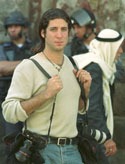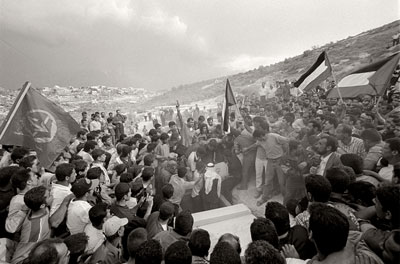 |
 |
Cycle of Violence
December 2003
|
 |
|||
|
I arrived in Israel exactly 4 years ago this month for what was supposed to be a 3-week visit. Arriving alongside hundreds of photographers and film crews I came here to document the Holyland during the Turn of the Century. When I arrived, I was slightly disappointed with the lack of Y2K Crazies, Cults, Fanatics, or the appearance of any Messianic figures besides a self-proclaimed Prophet named Bob. Forced to seek other projects here, I was surprised and pleased to find the emergence of many active joint Arab-Jewish organizations working together around the country and I began photographing a "Coexistence" project. Real peace between these two mortal enemies seemed to be within reach. Now, those days seem like a lifetime ago. Although some of these peace groups still exist, most have faded after the 3 year Intifada or Palestinian uprising. Like other photographers and writers working in Israel, I became engrossed in "the story" here and decided to stay and follow it. As many of you know, Israel is a difficult place to work. As many of my colleagues here, I have been beat up, had cameras smashed by Palestinian rock-throwers, chased out of Israeli funerals, shot at, and even once had a washing machine thrown at my car up in Uhm el Fahm. Depicting images of this complex 3,000 year old conflict is not easy, although I have tried to remain as "objective" as possible here. At times I have been accused by either side -- Palestinian friends who were upset by my images of them as gun-toting fighters, Israeli friends that claim my pictures show them as emotionless. This is a complex situation, however, I shoot what is in front of me at the time, and do not create the situation I am photographing. If I weren't there, this situation would still exist. I find it interesting that both in Gaza and Tel Aviv, I often hear the same complaints - that the media is biased against them. I believe that both sides have legitimate claims in this conflict, and both sides use wrong measures to achieve them. Unfortunately, this has led to an uncontrollable cycle of violence.
Yesterday, I was driving with another foreign photographer to take pictures in an Israeli Prison. On the way up, he mentioned to me his father was a survivor of the Holocaust. Not surprisingly he grew up feeling a strong connection with Israel and believes its existence is crucial for the Jews, especially with the rise of Anti-Semitism across Europe. He feels at home here and wants to become an Israeli citizen. I could not help thinking of a similar conversation I had with a Palestinian woman I was photographing last year in Ramallah, whose father was killed by Israeli commandos after hijacking a plane to Tel Aviv. She and her family had fled their home in East Jerusalem, but she came back here with Arafat after Oslo, and spoke about the feelings she had when she arrived. How everyone here spoke "Palestinian" Arabic in the streets and how she too felt this was her home. I used to believe real peace was an achievable dream here. Over the past 3 years I have seen hatred the likes of which I never knew existed - on both sides of this conflict. It will take generations to repair what has been destroyed with this Intifada. With such sentiments the best one can hope for these days is simply a lack of war. But is a lack of war, peace? One day I hope to return to my project on Coexistence. Unfortunately, until one side or the other truly decides to take the brave step of halting this cycle of violence, it may be a while.
© David Blumenfeld
|
||||
|
Write a Letter to the Editor
Join our Mailing List
© The Digital Journalist
|
